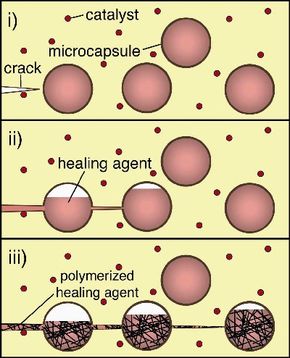When you cut yourself, it's amazing to watch how quickly your body acts to mend the wound. Immediately, your body works to pull the skin around the cut back together. If you have a scar, you can see the evidence of our bodies' self-healing power. Scientists are now developing a new type of composite material that will give those same self-healing qualities to spacecraft.
If humans plan to travel far into space and to interstellar planets, new advanced materials will be needed for spacecraft construction. One weakness of current composite materials is that they tend to form tiny hairline cracks, which will cause major damage over time. In February 2001, researchers at University of Illinois at Urbana Champaign announced that they have developed a new synthetic material that will heal itself when cracked or broken.
Advertisement
This new smart material and other technologies like it could be the first step in building a spacecraft capable of traveling millions of miles from Earth, where repairs won't be easy to make. In this edition of How Stuff WILL Work, you will learn about this new self-healing composite and electronics system that analyzes and fixes itself before problems become too great.

